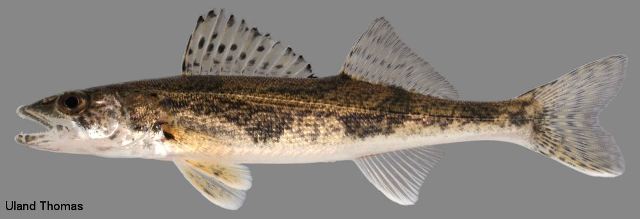Sauger
(Sander canadense)

A good place to fish for sauger in Ohio is on the downstream side of any of the lock and dam systems on the Ohio River.
Description
The sauger is similar in appearance to the walleye or the hybrid between the two known as the saugeye. They have many dark spots on their dorsal fin often forming rows. The first dorsal fin is usually relatively clear in unspotted areas, and there is not a large dusky area at the rear base of the fin as in walleye. The over all body coloration of a sauger is a bronze or brown color compared to the usual gray or more silver color of a walleye. The sauger has large dark oblong blotches on the sides of their body which are more visible when the fish are sitting still. Sauger do not have large white edges to the lower part of their tail and anal fin like a walleye, at best they have a very thin lighter colored edge that is often more yellow in color.
Habitat and Habits
Sauger were historically abundant in Lake Erie, the Ohio River and their larger tributaries. Today the sauger is still very common in the Ohio River and its larger tributaries upstream to the first dam. In Lake Erie and its tributaries they have become a rather rare catch but small numbers are still present. Saugers prefer large murky rivers or large shallow lakes. They tend to prefer water that is less clear than what walleye do as well as shallower depths.
Reproduction and Care of the Young
Sauger spawn in the spring when water temperatures reach the upper 40s. Females lay between 10,000 to 50,000 eggs. The eggs are adhesive and stick to vegetation, sticks, and stones until they hatch in about 10 days. Saugers are migratory and large upstream spawning runs occur in early spring. No parental care is given to the young.